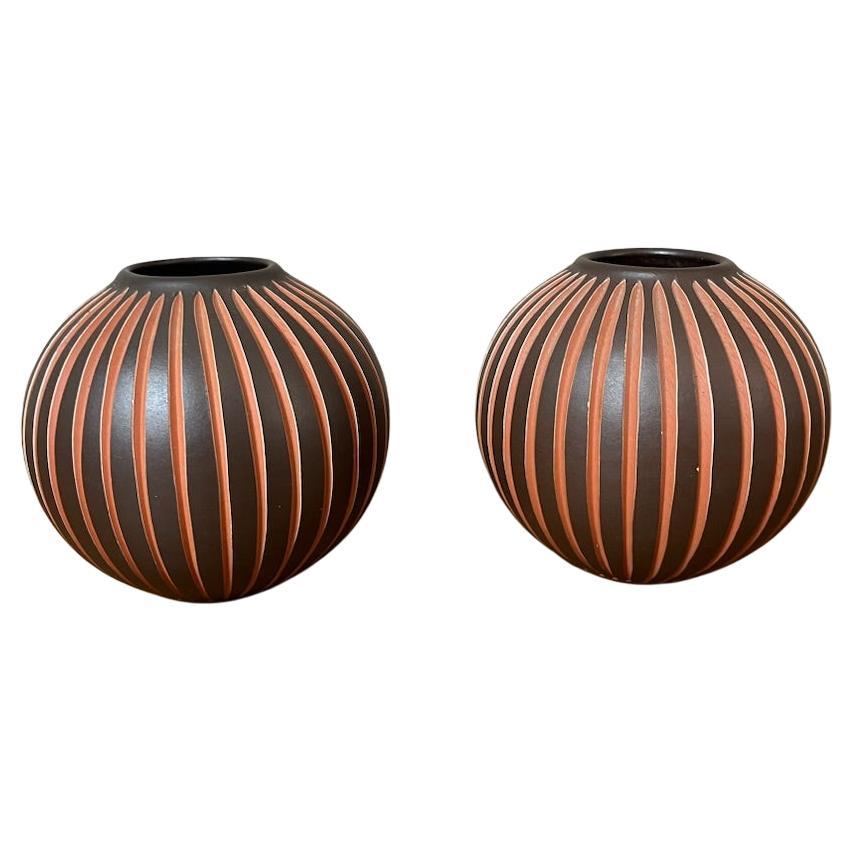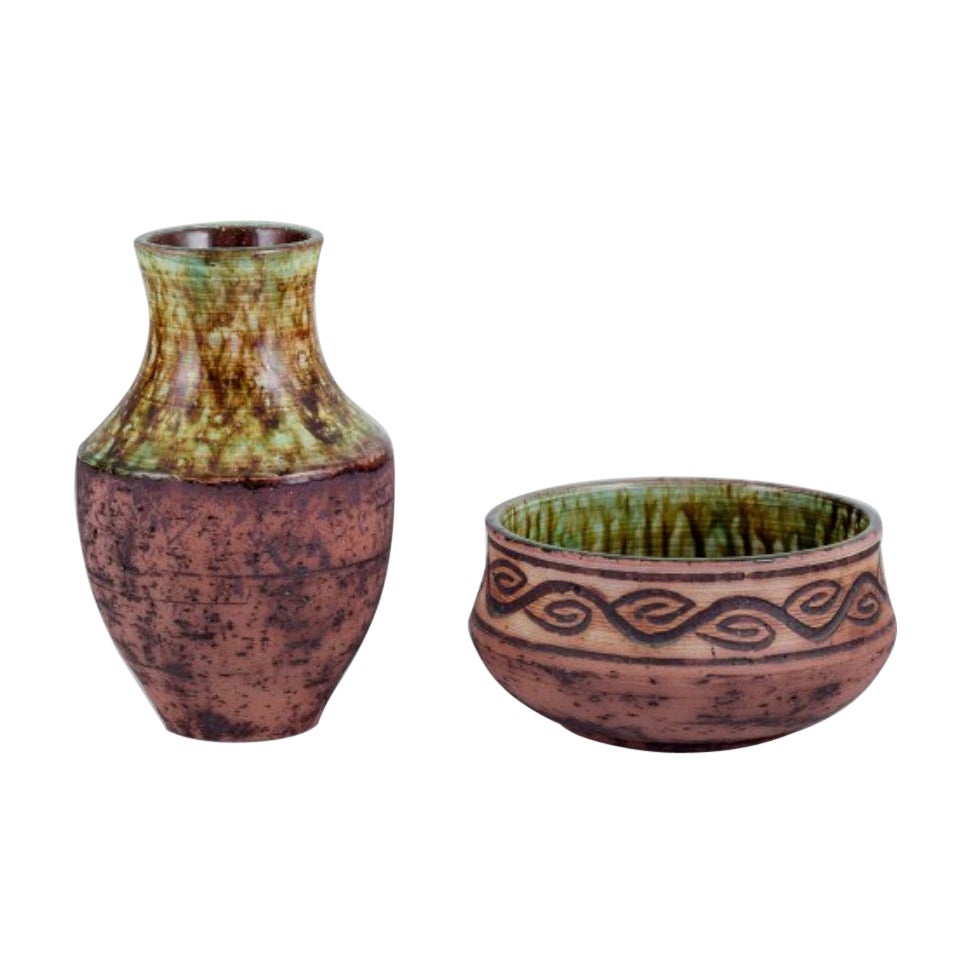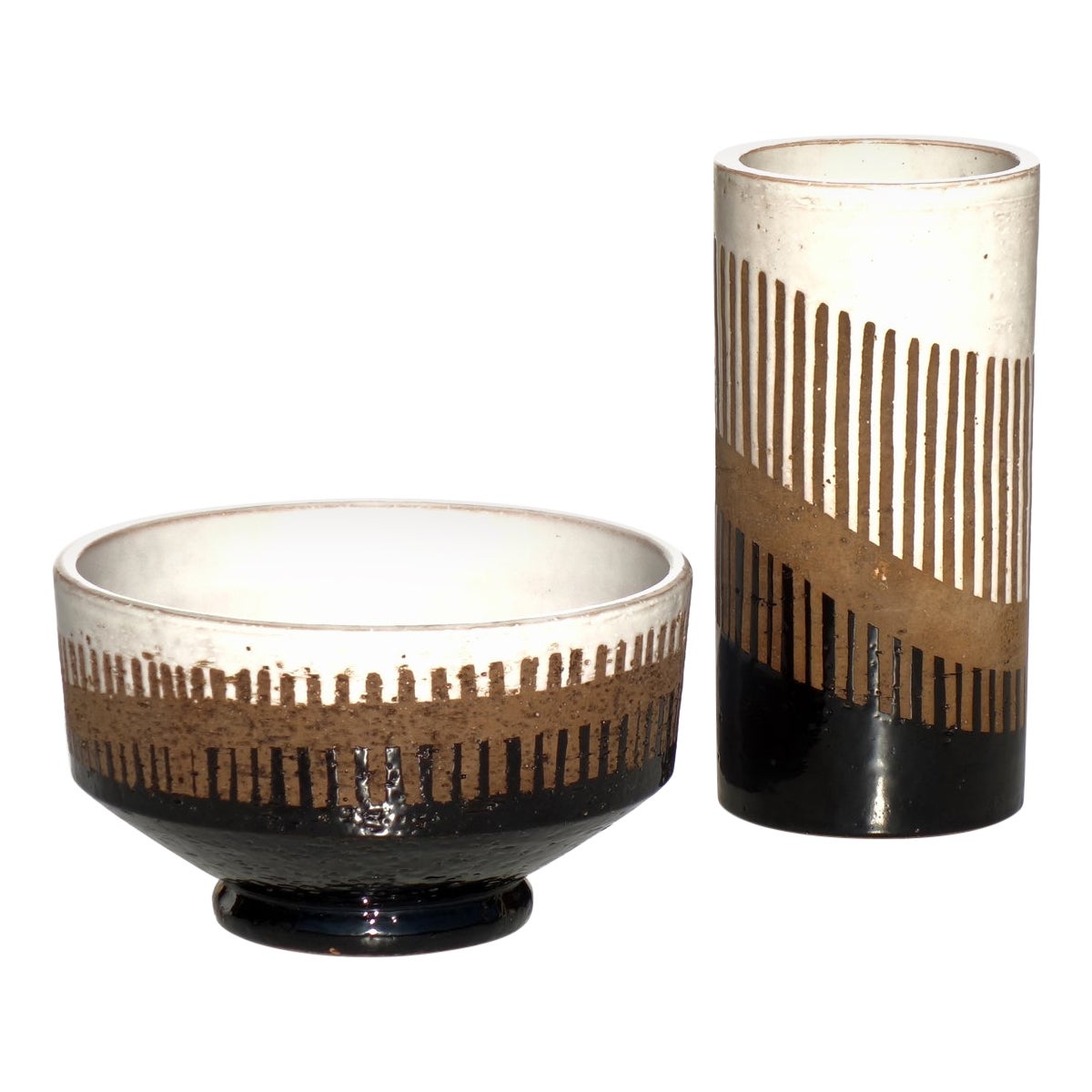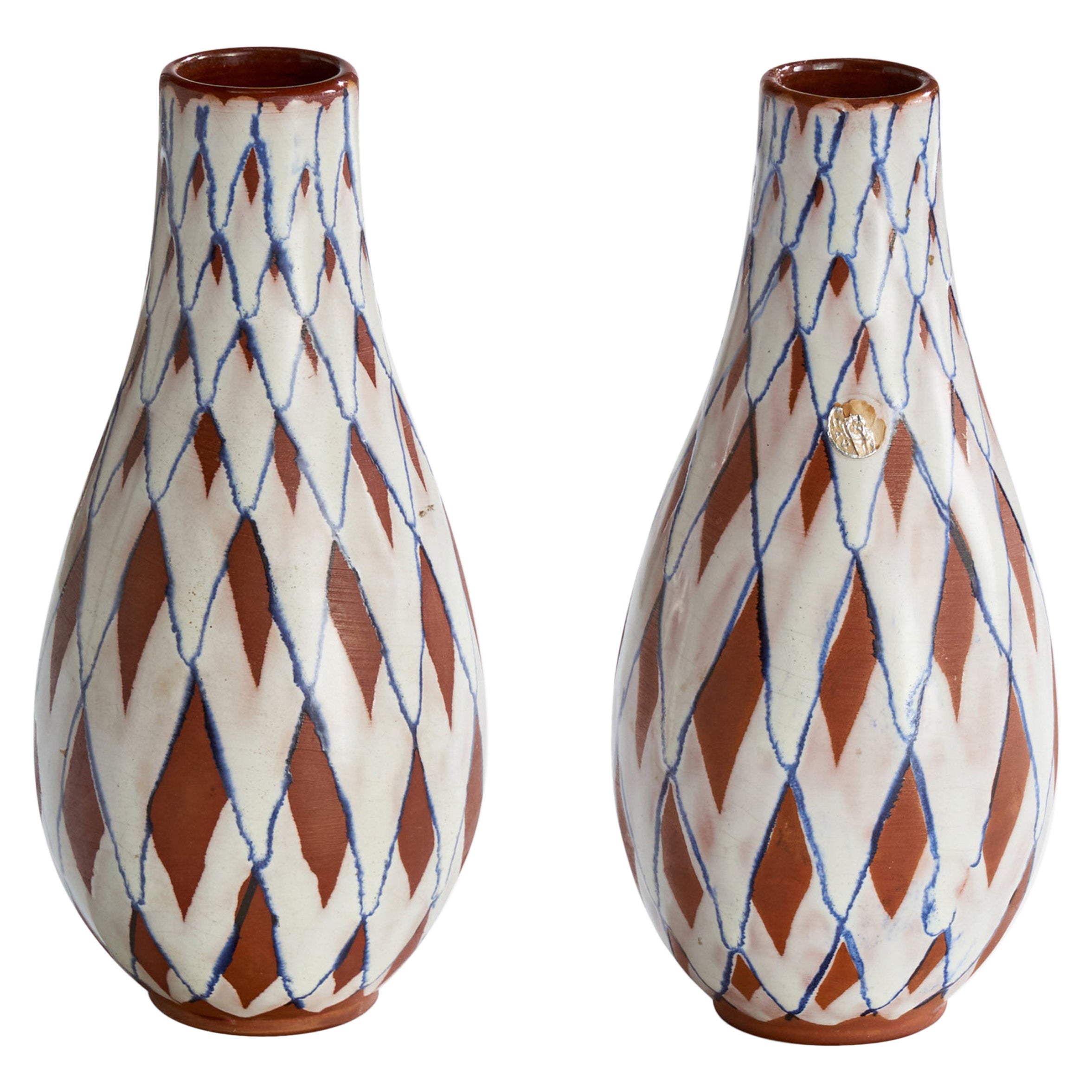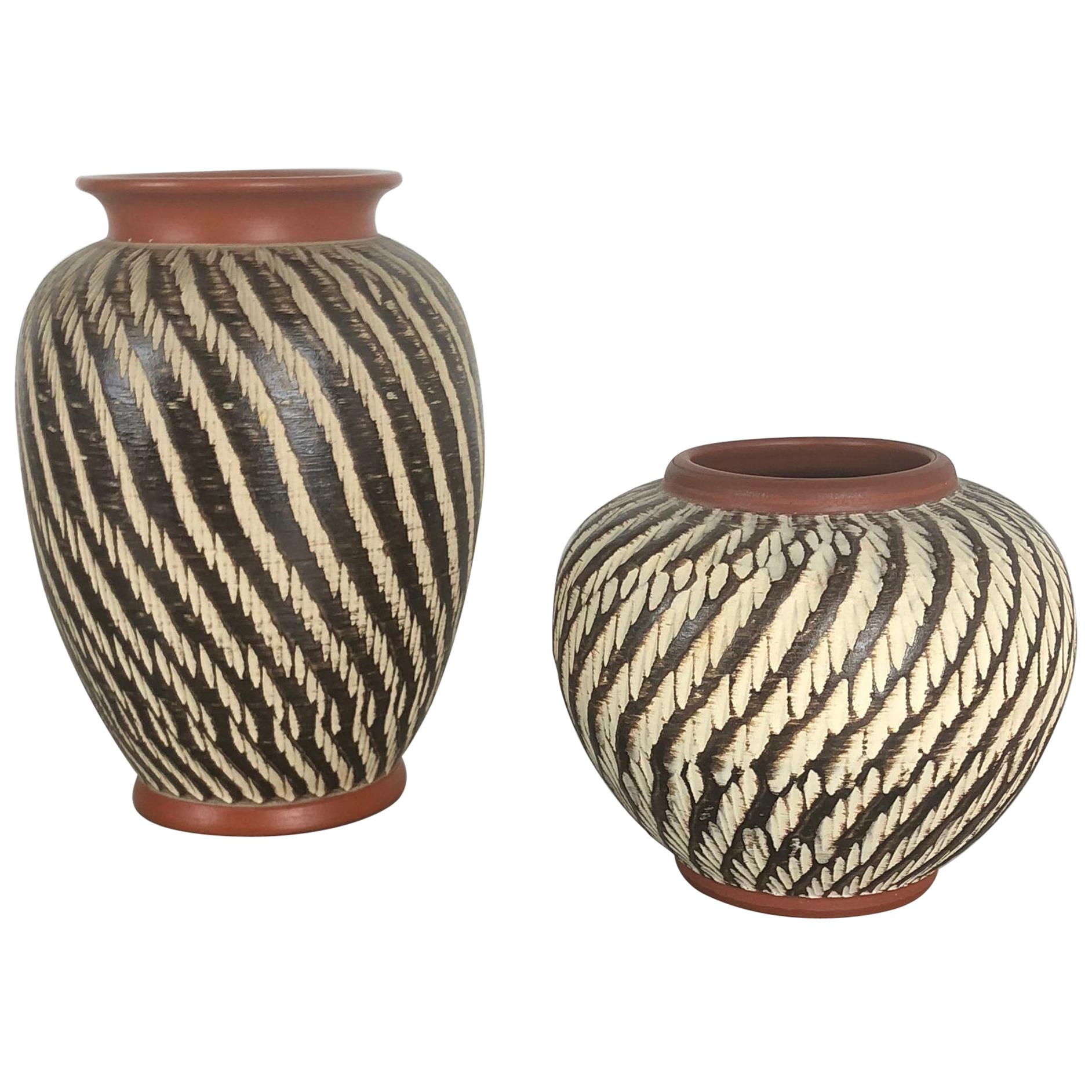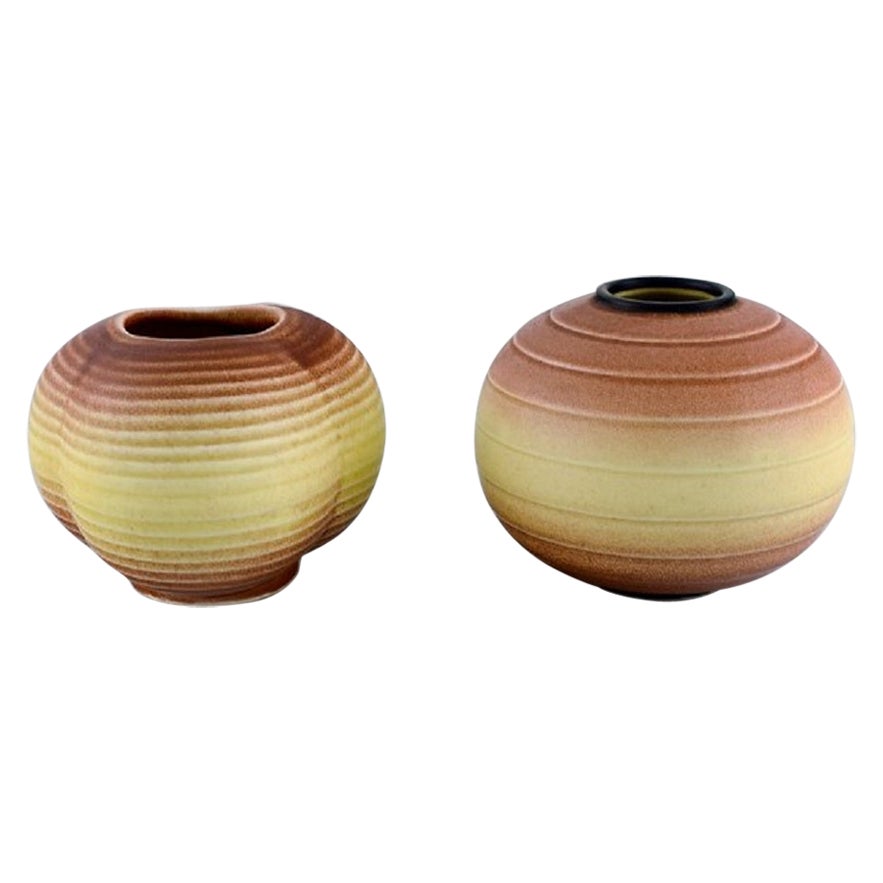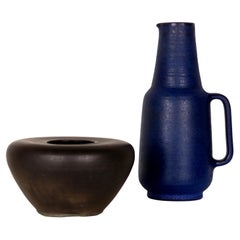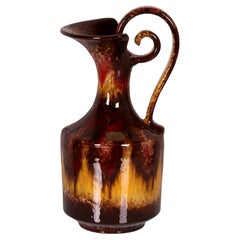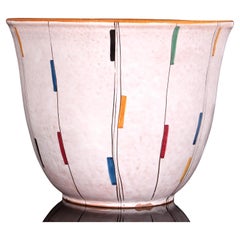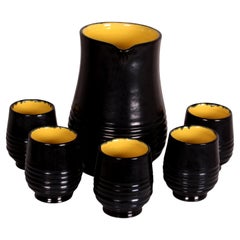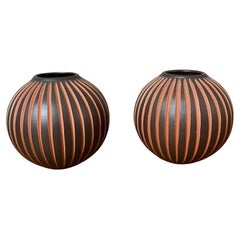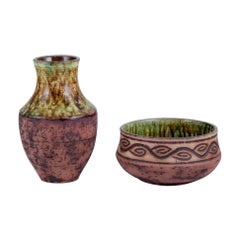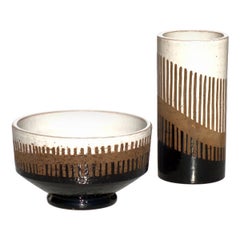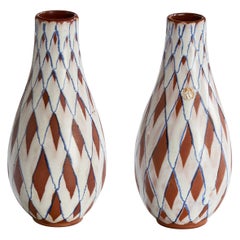Items Similar to midcentury art pottery SET of cachepot and vase both same unique gloss glaze
Want more images or videos?
Request additional images or videos from the seller
1 of 12
midcentury art pottery SET of cachepot and vase both same unique gloss glaze
$612.71per set
$765.89per set20% Off
£455.14per set
£568.93per set20% Off
€512per set
€640per set20% Off
CA$845.28per set
CA$1,056.60per set20% Off
A$929.19per set
A$1,161.49per set20% Off
CHF 488.34per set
CHF 610.43per set20% Off
MX$11,283.80per set
MX$14,104.75per set20% Off
NOK 6,091.94per set
NOK 7,614.93per set20% Off
SEK 5,771.69per set
SEK 7,214.61per set20% Off
DKK 3,897.61per set
DKK 4,872.01per set20% Off
About the Item
Landshut artist Peter Landesberger
cachepot plus a matching vase
1960s
measurements:
cachepot: height : 18cms ~ Ø 22cms ~ weight: 1422 grs
vase : height: 22cms ~ Ø 14cms ~ weight: 842 grs
Brush mark LP
Landshut, a town in Bavaria, Germany, is known for its ceramics school and its historical significance. The construction of Landshut began in 1204 under the rule of Duke Ludwig of Bavaria. It was a typical Wittelsbach founding town and marked a new form of territorial politics for the Bavarian dukes. From 1231, Landshut became the residence of the Wittelsbach dynasty and the capital of the Duchy of Bavaria until 1255. Due to the division of Bavarian lands, Landshut alternated between being a capital and a residential town. The town thrived thanks to its location on the Isar River and its strategic positioning along trade routes. By the 14th century, Landshut had developed its Gothic town center, which remained largely unchanged until the 19th century. During the period from 1392 to 1503, Landshut experienced a prosperous and politically important era under the rule of the three "rich" Dukes Heinrich, Ludwig, and Georg. Landshut also gained prestige through the magnificent wedding of Duke George the Rich to the daughter of the Polish king in 1475. This event, known as the "Landshut Wedding," is re-enacted every four years since 1903.
A historical overview of the renowned Keramikschule Landshut, situated in Lower Bavaria, reveals that the institution was founded in 1836 with the opening of the Agricultural and Commercial School in the current government building of the Government of Lower Bavaria.
In 1870, the first proposal for the establishment of a pottery school was put forth by the mayor Dr. Gehring, the principal of the trade school Sperl, and the master potter F. Reither.
In 1873, the Royal Pottery School opened its doors with the support of President von Lipowsky. The inaugural cohort comprised two journeymen, with a further three joining them subsequently, along with two apprentices. The teaching staff comprised the following individuals: The practical aspects of the curriculum were overseen by Franz Reither, while Friedrich Schenk was responsible for theoretical instruction. Adolf Böhm was in charge of financial matters. Subsequently, the following individuals were also involved: Anton Weinzierl
In order to be admitted to the school, it was necessary to have completed an apprenticeship. The pupils resided in a boarding house. The lights were extinguished at 9 p.m., and journeymen were required to remain in their rooms until 10 p.m. Visiting pubs was discouraged, as it was deemed incompatible with the standards of moral conduct expected of the pupils.
The consciousness of belonging to the pottery school must serve to elevate the young craftsman, increase his sense of honour and express itself in all his actions. (Quoted from: 'The State School of Ceramics in Landshut' by Gertrud Benker)
The working day commenced at 6.00 a.m. and concluded at 6.00 p.m., with a two-hour break. The primary focus of the school was the production of kilns. All manufactured goods were subsequently sold. Pupils were remunerated with a daily wage of 69 Pfennig. Theory lessons were conducted at the vocational school in the government building, while practical lessons were held at the former Graf factory in Bauhofstraße.
1903
Change of name: 'Keramische Fachschule Landshut' (additional title: Fachschule für Kunsttöpferei und Ofenbau) Move to a new building: (Ober-) Realschule am Marienplatz (today FOS). The school consisted of two years of pre-school, two years of vocational school and one year of further training for journeymen. Teachers: Wilhelm Rudolph (Reallehrer) and seven specialist teachers. School fees were 20 marks a year for Germans and 40 marks for foreigners.
30.1.1912
The pre-school examination was equated with the journeyman's examination and the technical school examination with the master's examination.
1924
Move to the preparatory school at Marienplatz (now KFL).
1930-1973
Opportunity to train as a bricklayer
1941
Master School for Ceramics, State Vocational School and Vocational College
1946
Licence to re-open after the war
1983-1988
Reconstruction of the old brickworks school
1983
Foundation of the 'Friends and Sponsors of the Landshut Ceramic Schools'.
- Dimensions:Height: 7.09 in (18 cm)Diameter: 8.67 in (22 cm)
- Sold As:Set of 2
- Style:Mid-Century Modern (Of the Period)
- Materials and Techniques:
- Place of Origin:
- Period:
- Date of Manufacture:1964-1968
- Condition:
- Seller Location:Landshut, DE
- Reference Number:1stDibs: LU8587242462972
About the Seller
5.0
Vetted Professional Seller
Every seller passes strict standards for authenticity and reliability
1stDibs seller since 2023
21 sales on 1stDibs
- ShippingRetrieving quote...Shipping from: Bodenkirchen , Germany
- Return Policy
Authenticity Guarantee
In the unlikely event there’s an issue with an item’s authenticity, contact us within 1 year for a full refund. DetailsMoney-Back Guarantee
If your item is not as described, is damaged in transit, or does not arrive, contact us within 7 days for a full refund. Details24-Hour Cancellation
You have a 24-hour grace period in which to reconsider your purchase, with no questions asked.Vetted Professional Sellers
Our world-class sellers must adhere to strict standards for service and quality, maintaining the integrity of our listings.Price-Match Guarantee
If you find that a seller listed the same item for a lower price elsewhere, we’ll match it.Trusted Global Delivery
Our best-in-class carrier network provides specialized shipping options worldwide, including custom delivery.More From This Seller
View AllSET of 2 art pottery Vases late 60s by Barbara Lampe :: Anton Lang Oberammergau
Located in Landshut, BY
"Set of two masterfully crafted vases by Barbara Lampe, granddaughter of company founder Anton Lang from Oberammergau (January 17, 1875 - May 30, 1 938) was a German studio potter an...
Category
Vintage 1970s German Mid-Century Modern Vases
Materials
Pottery
a quite unique art pottery vase Italy 1970s (appears to be composed of glass ! )
Located in Landshut, BY
This is an exceptional example of Italian design and craftsmanship.
The jug-style vase with a handle initially appears to be composed of glass. Upon closer examination, it becomes ...
Category
Vintage 1970s Italian Mid-Century Modern Vases
Materials
Pottery
$497 Sale Price
20% Off
GIANT Cachepot Planter 1950s by Huber Roethe Landshut mid-century art pottery
By Huber-Roethe
Located in Landshut, BY
GIANT
Cachepot Planter 1950s
by Huber Roethe Landshut (that´s where we´re based)
mid-century art pottery
Design Period mid 1950s
Production Period 1952-1957
Country of Manufact...
Category
Mid-20th Century German Mid-Century Modern Planters, Cachepots and Jardi...
Materials
Pottery, Ceramic
SET of midcentury Italy Grottaglie Drink Set Jug + 5 cups art pottery
Located in Landshut, BY
beautiful elegant artful Italian midcentury
Drinks Set
includes 5 cups
Famous art pottery from Grottaglie / Puglia Italy
by Ciro Farina
Design Period 1956 to 1964
Production Per...
Category
Mid-20th Century Italian Mid-Century Modern Pottery
Materials
Pottery
$938 Sale Price / set
20% Off
German Floor Vase DECORA 50s 60s sgrafitto hand-thrown KLINKER POTTERY 56/40
By Sawa Ceramic
Located in Landshut, BY
FLOOR VASE
DECORA
Ritzdekor (sgrafitto)
A 40cm late50s / early 60s studio quality 'Klinker' floor vase nr. 56/40 with an sgraffito
decor designed for DECORA Keramik.
It is comp...
Category
Vintage 1960s German Mid-Century Modern Vases
Materials
Pottery
$306 Sale Price
28% Off
SET of midcentury artful Punch Bowle Punchbowle + 6 cups Finland art pottery
Located in Landshut, BY
midcentury artful Punchbowle set
includes 6 cups
Made in Finland
art pottery
A stunning composition of earthy colours with a mystical turquoise hue.
Design Period 1968 to 1976
...
Category
Mid-20th Century Finnish Mid-Century Modern Jars
Materials
Pottery
$938 Sale Price / set
20% Off
You May Also Like
Mid-century, German Designer Wormser Ceramic Pair of Vases, 1950s
Located in LEGNY, FR
Add character to your interior with this stunning pair of handmade Mid-Century pottery vases by Wormser, a German Designer from the mid-century. With their soft shapes and natural fi...
Category
Vintage 1950s German Mid-Century Modern Vases
Materials
Ceramic
Szilasi, Visby, Sweden. Unique ceramic bowl and vase. Ca 1960
Located in København, Copenhagen
Szilasi, Visby, Sweden. Unique ceramic bowl and vase.
Glazed in green-brown tones.
Ca. 1960.
Incised signature.
In perfect condition.
Bowl: Diameter 14.0 cm x Height 7.5 cm.
Vase: H...
Category
Vintage 1960s Swedish Scandinavian Modern Vases
Materials
Ceramic
1950 Bitossi Ceramic Italian Mid Century Modern Vase, Set of 2
By Bitossi
Located in Brescia, IT
Bitossi
Italy, 1950
Set of 2
Ceramic vases
Excellent condiction
Vase: h 23 / diam 11 cm
Bowl: h 12 / diam 20 cm
Category
Vintage 1950s Italian Mid-Century Modern Vases
Materials
Ceramic
Gabriel Keramik, Vases, Ceramic, Sweden, 1940s
By Gabriel Keramik
Located in High Point, NC
A pair of blue, white and red hand-painted vases designed and produced in Sweden, c. 1940s.
Category
Vintage 1940s Swedish Scandinavian Modern Vases
Materials
Ceramic
$2,200 / set
Set of Two Vintage Pottery "abstract" Vases Made by WEKARA, Germany, 1960s
Located in Kirchlengern, DE
Article:
Set of two abstract vases
Producer:
WEKARA, Germany
Decade:
1960s
These original vintage vases was produced in the 1960s in Germany. It is made o...
Category
Late 20th Century German Mid-Century Modern Vases
Materials
Ceramic
Gertrud Lönegren '1905–1970 for Rörstrand, Two Round Vases in Glazed Ceramics
Located in København, Copenhagen
Gertrud Lönegren (1905–1970) for Rörstrand. Two round vases in glazed ceramics. Beautiful peach glaze. 1930s / 40s.
Largest measures: 12 x 9.5 cm.
In excellent condition.
Stamped.
Category
Vintage 1930s Swedish Scandinavian Modern Vases
Materials
Ceramic
More Ways To Browse
Vintage Bavarian
Young Mid Century Modern Dining Set
Edward Hall Orrefors
Fo Dog
French Ceramic Tall Vase
French Modern Studio Pottery
French Portrait Vases
Gaetano Indian Summer
Gaetano Pesce Indian Summer
Garlic Vase
Green Jasperware
Heintz Vase
Interior Form Furniture
Italian Face Art
Japanese Floor Vase
Kosta Boda Etched
Kpm Bavaria
Large Pair Murano Vases
